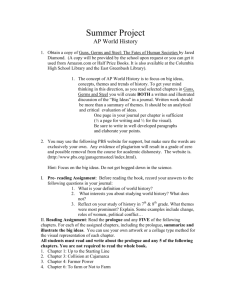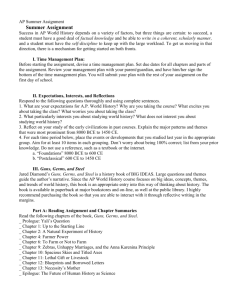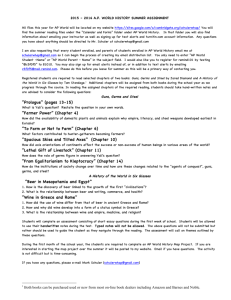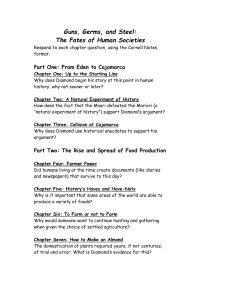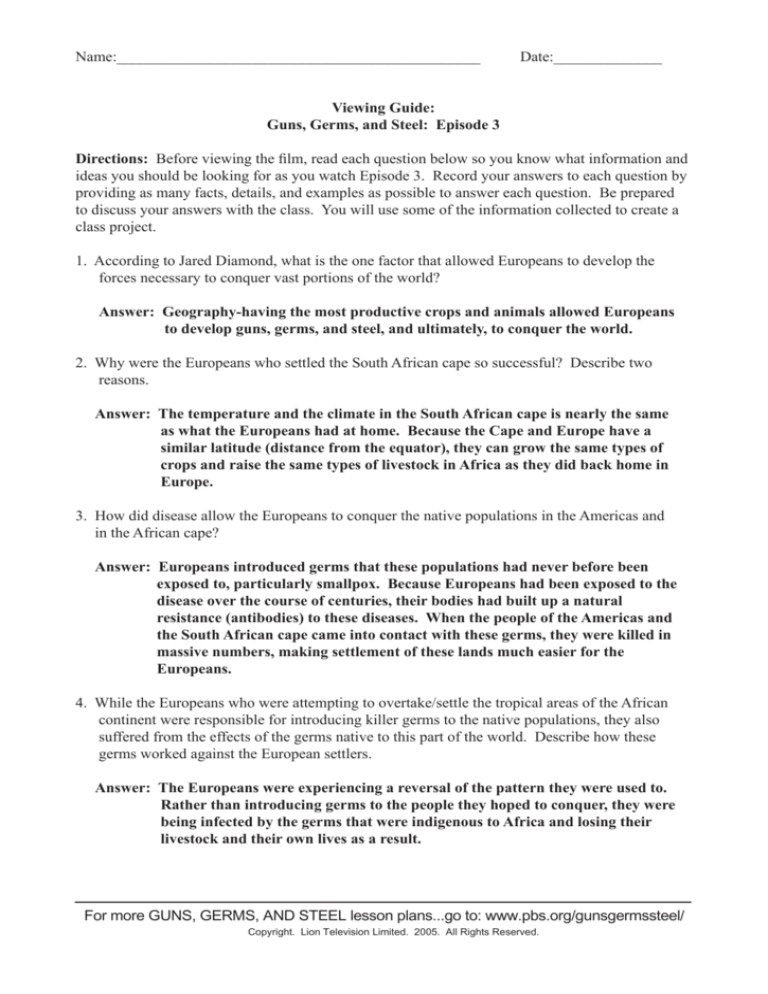
Name:_______________________________________________
Date:______________
Viewing Guide:
Guns, Germs, and Steel: Episode 3
Directions: Before viewing the film, read each question below so you know what information and
ideas you should be looking for as you watch Episode 3. Record your answers to each question by
providing as many facts, details, and examples as possible to answer each question. Be prepared
to discuss your answers with the class. You will use some of the information collected to create a
class project.
1. According to Jared Diamond, what is the one factor that allowed Europeans to develop the
forces necessary to conquer vast portions of the world?
Answer: Geography-having the most productive crops and animals allowed Europeans
to develop guns, germs, and steel, and ultimately, to conquer the world.
2. Why were the Europeans who settled the South African cape so successful? Describe two
reasons.
Answer: The temperature and the climate in the South African cape is nearly the same
as what the Europeans had at home. Because the Cape and Europe have a
similar latitude (distance from the equator), they can grow the same types of
crops and raise the same types of livestock in Africa as they did back home in
Europe.
3. How did disease allow the Europeans to conquer the native populations in the Americas and
in the African cape?
Answer: Europeans introduced germs that these populations had never before been
exposed to, particularly smallpox. Because Europeans had been exposed to the
disease over the course of centuries, their bodies had built up a natural
resistance (antibodies) to these diseases. When the people of the Americas and
the South African cape came into contact with these germs, they were killed in
massive numbers, making settlement of these lands much easier for the
Europeans.
4. While the Europeans who were attempting to overtake/settle the tropical areas of the African
continent were responsible for introducing killer germs to the native populations, they also
suffered from the effects of the germs native to this part of the world. Describe how these
germs worked against the European settlers.
Answer: The Europeans were experiencing a reversal of the pattern they were used to.
Rather than introducing germs to the people they hoped to conquer, they were
being infected by the germs that were indigenous to Africa and losing their
livestock and their own lives as a result.
For more GUNS, GERMS, AND STEEL lesson plans...go to: www.pbs.org/gunsgermssteel/
Copyright. Lion Television Limited. 2005. All Rights Reserved.
Name:_______________________________________________
Date:______________
Viewing Guide:
Guns, Germs, and Steel: Episode 3
5. How did the native Africans protected themselves from the germs that caused diseases such as
Smallpox and Malaria? Give specific examples cited in the film.
Answer: The native Africans had developed immunity to Smallpox through repeated
exposure over thousands of years and vaccinations they had developed that could provide
immunity for life. In addition, the Africans also knew how to avoid diseases like Malaria
by preventing infection. This was done by choosing to live in high, dry areas where the
mosquitoes responsible for spreading the disease do not typically live. Because the
Africans lived in small communities spread out over relatively large areas, they could
minimize the transmission of diseases such as Malaria when outbreaks occurred. Because
European settlers did not understand the causes of Malaria, they concentrated their
settlements near rivers and water sources where they faced the greatest exposure to
Malaria. Because they all lived in close proximity, epidemics were frequent and deadly to
the settlers.
6. How has the colonization of Africa created countries riddled with disease? Give
specific examples from the film.
Answer: Because European colonists in the late 1800’s forced the native Africans out of
their small villages and into cities and large, crowded communities to mine and ferry the
continent’s natural resources, they took the successful economic and social systems away
from these people. By putting so many people together in areas where diseases like Malaria
are easily spread, the native populations have lost the immunity they once had to these
diseases. This is caused, in part, by the strains of the disease mutating, causing drugs to be
less effective. As a result, there are high numbers of people infected with and dying from
diseases like Malaria. In addition, new diseases, such as HIV/AIDS are now also spread
more easily because of so many people living in densely populated areas.
7. What is the number one public health problem in Zambia, and who are the people primarily
affected by this?
Answer: Malaria. It is the number one killer of African children under the age of 5.
8. How has disease contributed to the poverty in many African countries such as Zambia?
Answer: It has decreased life expectancy dramatically. The average lifespan in Zambia is only
35 years. Because the disease affects so many children so frequently, many mothers who
would normally be working and contributing to the society are instead sitting in hospitals
nursing sick children.
9. According to statistics from the film, how has Malaria effected the net growth in Africa over the
last 50 years?
Answer: Malaria has caused 1% NEGATIVE growth in Africa EACH YEAR for the past
50 years. This has caused them to become poverty stricken.
For more GUNS, GERMS, AND STEEL lesson plans...go to: www.pbs.org/gunsgermssteel/
Copyright. Lion Television Limited. 2005. All Rights Reserved.
Name:_______________________________________________
Date:______________
Viewing Guide:
Guns, Germs, and Steel: Episode 3
10. Describe how other tropical countries such as Malaysia and Singapore have developed rich
economies despite having many of the same geographical and health problems faced by
African nations.
Answer: By understanding their environment and realizing the burdens that their
geography and certain germs could cause, these governments planned and executed
measures to eliminate diseases like Malaria. As a result, they were able to develop rich
economies and capitalize on the positive aspects of their geography.
11. Now that you have read “The Story of Smallpox and Other Eurasian Germs”, describe what
you have learned about Smallpox including the causes, symptoms, means for spreading the
disease, and how immunity to the disease can be developed.
Answer: Smallpox is a viral infection that usually enters the body through the nose or
throat. From here the virus travels to the lungs, where it multiplies and spreads to the
lymphatic system. Within a few days, large blisters begin to appear all over the victim’s
skin. Starting with the hands and the face, and then spreading to cover the rest of the
body, each blister is packed full of smallpox DNA. If punctured, these blisters become
highly infectious, projecting fresh smallpox particles into the air and onto surrounding
surfaces – like someone else’s skin!
The total incubation period lasts around 12 days, by which point the patient will either
die or survive – but throughout that period, he may have passed the disease to an
enormous number of people. The disease requires close human contact to replicate and
survive.
For thousands of years, the people of Eurasia lived in close proximity to the largest
variety of domesticated mammals in the world – eating, drinking, and breathing in the
germs these animals bore. Over time, animal infections crossed species, evolving into
new strains which became deadly to man. Diseases like smallpox, influenza and measles
were in fact the deadly inheritance of the Eurasian farming tradition – the product of
thousands of years spent farming cattle, pigs, horses, goats and sheep.
These epidemic Eurasian diseases flourished in dense communities and tend to explode
in sudden, overwhelming epidemics of infection and death. Transmitted via coughing,
sneezing and touching, they wreaked devastation throughout Eurasian history – and in
the era before antibiotics, thousands would die.
With each epidemic eruption, some people would always survive, acquiring antibodies
and immunities which they could pass on to the next generation. Over time, the
population of Europe gained increasing levels of such immunity, and the devastating
impact of traditional infections decreased.
For more GUNS, GERMS, AND STEEL lesson plans...go to: www.pbs.org/gunsgermssteel/
Copyright. Lion Television Limited. 2005. All Rights Reserved.
Name:_______________________________________________
Date:______________
Viewing Guide:
Guns, Germs, and Steel: Episode 3
12. After reading “The Story of Malaria and Other Deadly Tropical Germs”, what are some of the
effective, simple, relatively inexpensive ways to prevent the spread of diseases such as
Malaria? In your opinion, why are these options not being used more widely by African
nations? Explain.
Answer: The use of new drugs and inexpensive vaccinations can be a great form of
prevention and treatment. In addition, education programs can be used to teach people
about how to minimize/prevent exposure and transmission of the disease. Finally, simple
measures, such as the use of insecticides and insecticide-treated bed nets, can have a
dramatic effect on the spread of disease.
Opinions about why these forms of prevention are not being used more frequently will
vary from student to student.
For more GUNS, GERMS, AND STEEL lesson plans...go to: www.pbs.org/gunsgermssteel/
Copyright. Lion Television Limited. 2005. All Rights Reserved.


